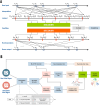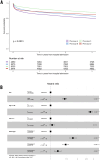Identifying acute illness phenotypes via deep temporal interpolation and clustering network on physiologic signatures
- PMID: 38600110
- PMCID: PMC11006654
- DOI: 10.1038/s41598-024-59047-x
Identifying acute illness phenotypes via deep temporal interpolation and clustering network on physiologic signatures
Abstract
Using clustering analysis for early vital signs, unique patient phenotypes with distinct pathophysiological signatures and clinical outcomes may be revealed and support early clinical decision-making. Phenotyping using early vital signs has proven challenging, as vital signs are typically sampled sporadically. We proposed a novel, deep temporal interpolation and clustering network to simultaneously extract latent representations from irregularly sampled vital signs and derive phenotypes. Four distinct clusters were identified. Phenotype A (18%) had the greatest prevalence of comorbid disease with increased prevalence of prolonged respiratory insufficiency, acute kidney injury, sepsis, and long-term (3-year) mortality. Phenotypes B (33%) and C (31%) had a diffuse pattern of mild organ dysfunction. Phenotype B's favorable short-term clinical outcomes were tempered by the second highest rate of long-term mortality. Phenotype C had favorable clinical outcomes. Phenotype D (17%) exhibited early and persistent hypotension, high incidence of early surgery, and substantial biomarker incidence of inflammation. Despite early and severe illness, phenotype D had the second lowest long-term mortality. After comparing the sequential organ failure assessment scores, the clustering results did not simply provide a recapitulation of previous acuity assessments. This tool may impact triage decisions and have significant implications for clinical decision-support under time constraints and uncertainty.
© 2024. The Author(s).
Conflict of interest statement
The authors declare no competing interests.
Figures




Similar articles
-
Physiologic signatures within six hours of hospitalization identify acute illness phenotypes.PLOS Digit Health. 2022;1(10):e0000110. doi: 10.1371/journal.pdig.0000110. Epub 2022 Oct 13. PLOS Digit Health. 2022. PMID: 36590701 Free PMC article.
-
Derivation, Validation, and Potential Treatment Implications of Novel Clinical Phenotypes for Sepsis.JAMA. 2019 May 28;321(20):2003-2017. doi: 10.1001/jama.2019.5791. JAMA. 2019. PMID: 31104070 Free PMC article.
-
Early Biomarker Signatures in Surgical Sepsis.J Surg Res. 2022 Sep;277:372-383. doi: 10.1016/j.jss.2022.04.052. Epub 2022 May 12. J Surg Res. 2022. PMID: 35569215 Free PMC article.
-
Derivation and validation of generalized sepsis-induced acute respiratory failure phenotypes among critically ill patients: a retrospective study.Crit Care. 2024 Oct 1;28(1):321. doi: 10.1186/s13054-024-05061-4. Crit Care. 2024. PMID: 39354616 Free PMC article.
-
Innate Immunity in the Persistent Inflammation, Immunosuppression, and Catabolism Syndrome and Its Implications for Therapy.Front Immunol. 2018 Apr 4;9:595. doi: 10.3389/fimmu.2018.00595. eCollection 2018. Front Immunol. 2018. PMID: 29670613 Free PMC article. Review.
References
-
- Hall, M. J., Levant, S. & DeFrances, C. J. Trends in inpatient hospital deaths: National Hospital Discharge Survey, 2000–2010. NCHS Data Brief, 1–8 (2013). - PubMed
-
- Weiss, A. J. & Elixhauser, A. Overview of hospital stays in the United States, 2012. In HCUP Statistical Brief #180 (Agency for Healthcare Research and Quality, 2014). - PubMed
MeSH terms
Substances
Grants and funding
LinkOut - more resources
Full Text Sources
Medical

